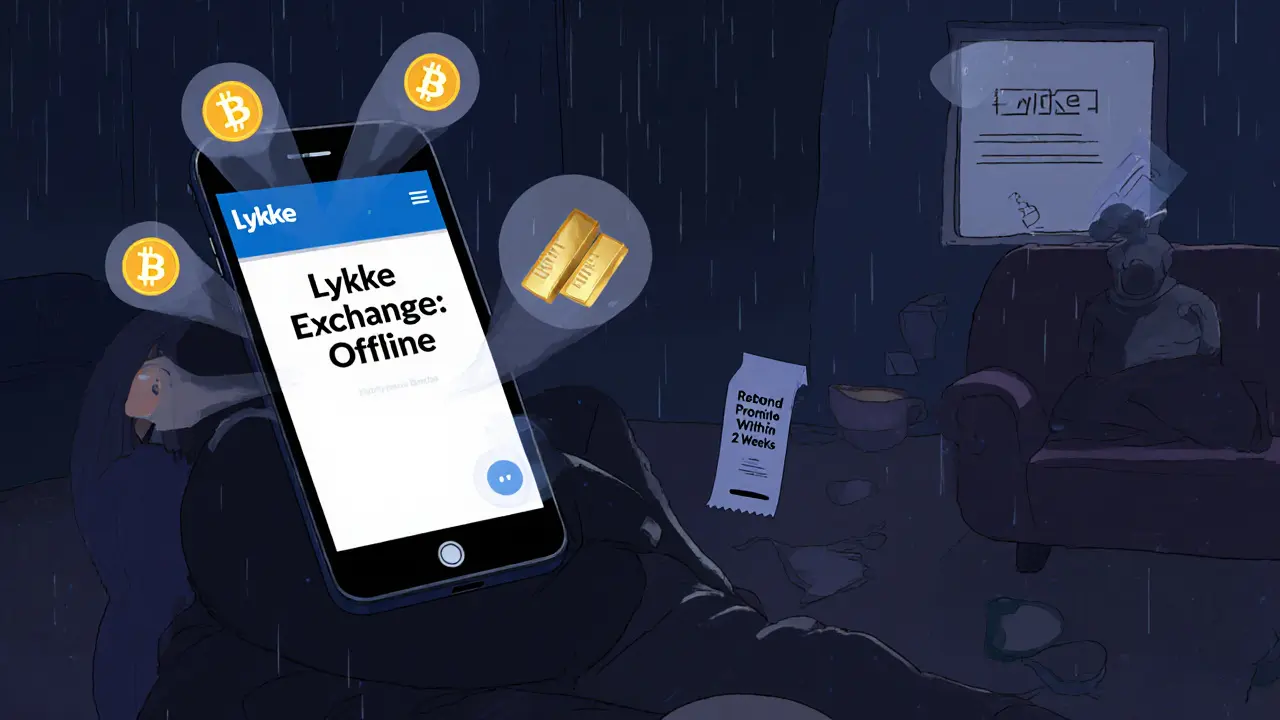Crypto Trading Cost Calculator
Understand the Real Cost of Zero-Fee Trading
Zero-fee exchanges like Lykke may look attractive, but they often compensate with wider spreads. This calculator shows you how spreads can make trading costs higher than fee-based exchanges.
Results
Lykke Exchange promised something rare in the crypto world: zero-fee trading. For a few years, it stood out with its clean interface, support for fiat currencies like EUR and GBP, and even digital gold and silver. But today, Lykke Exchange doesn’t exist as a functioning platform. Its website is offline. Its apps are gone from app stores. And thousands of users still can’t access their funds.
What Lykke Exchange Actually Offered
Lykke wasn’t just another crypto exchange. Launched in 2015 by Forex veteran Richard Olsen, it aimed to be a global marketplace for all kinds of assets - not just Bitcoin and Ethereum, but also USD, CHF, EUR, and digital versions of precious metals like platinum and palladium. That made it one of the few exchanges where you could trade gold for Bitcoin without leaving the platform. Its biggest selling point? Zero trading fees. While Binance charged 0.1% and Coinbase Pro took up to 0.5%, Lykke claimed 0% for both makers and takers. Withdrawals were cheap too - just 0.0005 BTC for Bitcoin, and free for fiat. Deposits via bank transfer or credit card had no fees from Lykke (though your bank might charge you). It also had a mobile app, available on iOS and Android, with margin trading and instant settlement. The interface was simple. KYC verification took under 48 hours. Customer support was responsive in the early days, with live chat available 24/7. But behind the smooth surface, problems were building. Liquidity was thin. Spreads - the gap between buy and sell prices - were wider than on bigger exchanges. That meant even if you weren’t paying fees, you were still losing money on every trade because the price moved against you before your order filled.The Security Claims That Never Held Up
Lykke claimed to have a clever security system called "colored tokens." The idea was simple: your Bitcoin or EUR balance wasn’t stored as real assets, but as digital tokens with color codes. If hackers stole them, Lykke said it could cancel those tokens and issue new ones - like replacing stolen cash with new bills. They also promised a refund policy: if your funds were lost in a hack, Lykke would reimburse you within two weeks. Sounds reassuring, right? It wasn’t. On June 4, 2024, hackers drained CHF 22.8 million (about $19.5 million) from Lykke’s wallets. That was roughly a quarter of all assets on the platform. Within hours, withdrawals stopped. The website went silent. The mobile apps stopped working. The "colored tokens" system didn’t save anyone. The refund policy? Never activated. Users who had $500 or $50,000 in their accounts saw their balances vanish - not because of market crashes, but because the exchange itself was breached and couldn’t recover.Why Users Lost Everything
By October 2024, Lykke posted a vague update: "The systems are ready for full operation. We are deciding whether all other conditions for continuation of operations are also met." It sounded hopeful. But nothing happened. By December 2024, the exchange was declared insolvent. Its own cryptocurrency, LKK, dropped to $0. The company stopped responding to emails. Support tickets went unanswered. User reviews on Trustpilot and Reviews.io tell the real story. One user wrote in June 2025: "Part of my Bitcoin has been stuck for over half a year. They didn’t fix it. I had to hire a recovery service just to get some of my money back." Another said: "I lost $3,200. They promised to refund me. Four months later, I got automated replies. No money. No answers." Out of 43 recent reviews as of November 2025, 87% reported total loss of access to their funds. No other exchange in recent memory has left so many users with zero recourse.
How Lykke Compared to Other Exchanges
Before the collapse, Lykke had around 150,000-200,000 active users. That’s tiny compared to Binance (120 million) or Coinbase (100 million). But it wasn’t the size that killed it - it was the lack of safeguards. Most major exchanges keep 95%+ of user funds in cold storage. They’re insured. They’re audited. Lykke didn’t have any of that. It wasn’t regulated by a strict financial authority like the Swiss FINMA - a fact even early reviewers like BrokerChooser warned about. Here’s how Lykke stacked up before its fall:| Feature | Lykke Exchange | Binance | Coinbase Pro | Kraken |
|---|---|---|---|---|
| Trading Fees | 0% | 0.1% (maker/taker) | 0.04%-0.50% | 0.16%-0.26% |
| Fiat Support | USD, EUR, CHF, GBP | USD, EUR, GBP, CAD, AUD | USD, EUR, GBP, CAD | USD, EUR, GBP, CAD, JPY |
| Precious Metals | Yes (Gold, Silver, Platinum, Palladium) | No | No | No |
| Liquidity | Low - wide spreads | Very High | High | High |
| Regulation | Not regulated by strict authority | Global compliance, licensed in multiple jurisdictions | Registered with FinCEN, licensed in U.S. | Registered with FinCEN, licensed in EU |
| Insurance | None | Yes (via third-party) | Yes | Yes |
| Withdrawal Reliability | Failed after June 2024 | Consistently reliable | Consistently reliable | Consistently reliable |
The takeaway? Lykke’s zero fees looked great on paper - but without liquidity, regulation, or insurance, it was a house of cards. When the wind blew, it collapsed.
What Happened After the Hack
After the June 2024 breach, Lykke’s team disappeared. No press releases. No updates. No refunds. The company’s website eventually went dark. The mobile apps vanished from Apple’s App Store and Google Play. CoinMarketCap and CoinGecko delisted Lykke in early 2025. Its token, LKK, became worthless. The company’s legal status is now officially defunct. There’s no known recovery process. No official channel to file claims. No lawyer or administrator has stepped forward to help users. Some people hired third-party crypto recovery firms - like Cryptorecoveryltd.com - and got back a fraction of their funds. But most never recovered anything.
Why Lykke Failed - The Real Reasons
Lykke didn’t fail because of bad luck. It failed because of bad choices:- No real regulation: Operating under Swiss law without FINMA oversight meant no accountability.
- No insurance: Unlike Coinbase or Kraken, Lykke didn’t insure user funds.
- Low liquidity: Thin order books made trading expensive, even with zero fees.
- Over-reliance on a single founder: Richard Olsen had experience in Forex, but not in managing a crypto exchange at scale.
- Unproven security model: "Colored tokens" sounded smart, but it was never tested under real attack - until it was too late.
It’s a classic case of a startup trying to out-innovate its way out of fundamental risks. In crypto, innovation without security is just a countdown.
What You Should Learn From Lykke
If you’re thinking about using a new exchange, ask these questions:- Is it regulated by a real financial authority? (Not just "based in Switzerland" - is it licensed by FINMA, FCA, or SEC?)
- Does it insure user funds? (Look for public insurance policies or third-party audits.)
- What’s its daily trading volume? (Below $1 million? That’s a red flag.)
- Are users complaining about withdrawals? (Check Trustpilot, Reddit, and CoinMarketCap reviews.)
- Is the "zero fee" model too good to be true? (It usually is.)
Lykke Exchange was a cautionary tale. It wasn’t a scam - it was a slow-motion disaster. And it happened to people who trusted it because it looked professional, had a clean app, and promised no fees.
Today, there are dozens of better, safer exchanges. Don’t risk your money on one that’s already gone.
Is Lykke Exchange still operational in 2025?
No. Lykke Exchange is defunct as of late 2024. After a $19.5 million hack in June 2024, it halted withdrawals, stopped responding to users, and was declared insolvent. Its website and apps are no longer accessible. It has been delisted from all major crypto tracking platforms.
Can I get my money back from Lykke Exchange?
Almost certainly not. Lykke never paid out refunds after the hack, despite promising to do so within two weeks. There is no official recovery process. Some users hired third-party crypto recovery services and recovered small portions of their funds - but most lost everything. The company has no legal entity left to file claims against.
Why did Lykke Exchange offer zero trading fees?
Lykke claimed it made money through spreads (the difference between buy and sell prices) and its proprietary LyCI service token. But the strategy failed because the exchange had low liquidity - meaning the spreads were too wide for traders to profit. Without volume, zero fees didn’t create revenue. Instead, it made the platform vulnerable to cash flow problems and ultimately, collapse.
Was Lykke Exchange regulated?
No. Although based in Switzerland, Lykke was not licensed or regulated by FINMA, the country’s strict financial watchdog. Experts like BrokerChooser warned as early as 2023 that this lack of regulation made it unsafe. Most reputable exchanges are regulated - Lykke was not.
What happened to Lykke’s LKK token?
The LKK token, which represented a 1/100th share of the company, became worthless after Lykke’s insolvency in late 2024. Its market value dropped to $0, and it was delisted from all exchanges. Holding LKK now has no financial value.
Should I use Lykke Exchange today?
Absolutely not. Lykke Exchange no longer operates. Its services are offline, its funds are inaccessible, and there is no path to recovery for users. Even if you find a website claiming to be Lykke, it’s a scam. Use only well-established, regulated exchanges with insurance and proven liquidity.
Sam Daily
November 25, 2025 AT 12:52Zero fees? Yeah, that’s the bait. The kind that makes you forget to check if the hook’s sharp. Lykke looked slick - clean app, fancy metals, no commissions - but no insurance, no regulation, no real liquidity? That’s not innovation, that’s Russian roulette with your Bitcoin. I lost $2k to a similar ‘too good to be true’ exchange back in ’21. Learned the hard way: if it’s too smooth, it’s probably grease.
Stay away from anything that doesn’t have a public audit or a FINMA license. Zero fees don’t pay your rent.
😂
Rachel Thomas
November 26, 2025 AT 07:19lol so lykke died because people were too dumb to read the fine print? wow. i thought crypto was supposed to be wild west. if you put your money in some random site that says ‘zero fees’ you deserve to lose it. my dog could’ve told you that. also why are you even mad? you’re not entitled to free money. grow up.
btw i still own 500 dogecoin. i’m rich.